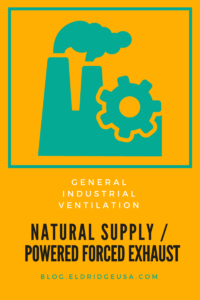This month, we cover perhaps the most common method for ventilating an industrial building: natural supply/powered forced exhaust.
Simply, powered exhaust fans are mounted on the roof of the building. The powered roof exhaust fans create a negative pressure condition within the building which allows for the natural draft of fresh outside supply air through any opening around the building perimeter.
Large open loading dock doors, overhead crane doors, or perimeter louvers all provide a way to get fresh outside supply air into the building. Typically, these exterior openings are sized so that the pressure drop vs airflow is very low in order to allow roof exhaust fans to operate very effectively and exhaust large volumes of air.
 As the fresh, natural supply air enters the building, it immediately begins to pick up internal heat and rise toward the ceiling. Powered roof exhaust fans strategically placed above the areas of highest internal heat source or towards the center of the building provide the overall building with an air change rate to facilitate worker comfort in the summertime.
As the fresh, natural supply air enters the building, it immediately begins to pick up internal heat and rise toward the ceiling. Powered roof exhaust fans strategically placed above the areas of highest internal heat source or towards the center of the building provide the overall building with an air change rate to facilitate worker comfort in the summertime.
The system creates a very low negative pressure within the building, which is desirable for many industrial operations. For example, it is desirable that the pressure within a fabrication and welding shop work area be slightly negative in relation to an adjacent air-conditioned office space. This prevents the buildup of welding or cutting table fumes in the ventilated work area and also prevents these fumes from migrating back into the office area.
This system is used in many industrial buildings with extremely high internal heat sources such as a forge shop or foundry where a very rapid air exhaust rate is required.
A natural supply/powered forced exhaust ventilation system is also very effective on industrial buildings that of low overall height–say only 20 to 25 feet to the eve–because internal process heat and solar load increases the work floor temperature within just a few hours during the hot summertime. The powered forced exhaust prevents this work level temperature buildup.
As for other advantages:
- Natural supply/powered forced exhaust system is not dependent on prevailing winds in order to operate effectively all the times.
- An overall building air change rate and slight negative building pressure can be guaranteed.
- Depending on the air change rate, the temperature throughout the building will be as close to the outside ambient temperature as possible.
- The initial equipment cost is reasonable based on a Cost/CFM basis and the overall operating cost is low based on a CFM/HP basis.
This sounds great for summer ventilation, but with all those perimeter building openings, how do you ventilate in the winter time?
For winter ventilation, direct heated air make-up units or space heaters can be used in order to add heat to the work area. Perimeter supply louvers and doors are simply closed in the winter under normal working conditions and roof exhaust fans can be turned off to maintain heat within the building. The overall air change rate is reduced in the winter to just a few times per hour. People can stay warm and dry even in the wintertime for improved productivity and health.
If the natural supply air comes into the building and immediately wants to rise toward the roof mounted exhaust fans, how do you get air movement at floor level near the center of a large building?
Because the natural supply is not forced into the building (it is an induced draft flow), it does not provide the floor level air movement that other systems can. However, when combined with column-mounted fans, the fresh outside air can be kept moving through critical work areas hundreds of feet away from natural supply openings.
CAN NATURAL SUPPLY AIR BE FILTERED TO MAINTAIN INTERIOR BUILDING CLEANLINESS?
Typically, it is impractical to filter natural supply air when powered roof exhaust fans are used. We are talking about a negative pressure, high volume ventilation system here. Adding filters to cover louvers or large open doors will increase the pressure required on the powered roof exhaust fans and reduce flow and increase fan horsepower. Also, because this system is always slightly negatively pressured, any leak in the building such as an electrical raceway, plumbing train entrance, or open man door is an invitation for dust to bypass the filters.
SUMMARY
Natural supply/powered forced exhaust is the most commonly used and cost effective method of industrial ventilation. It is an excellent way to ventilate an industrial building when a slight negative pressure is acceptable. The air change rate is not contingent on exterior conditions like wind, outside ambient temperature, the height of the building, temperature differentials, etc. When properly designed, it reduces the inside building temperature, prevents the buildup of internal heat, creates an interior work environment as close to the outside temperature as possible, and optimizes air movement for personnel comfort.
In the last installment in this series, we will be discussing the “green trend” to industrial ventilation: natural supply/natural exhaust. And if you missed our previous articles, check them out: Powered Forced Supply/Powered Forced Exhaust and Powered Forced Supply/Natural Exhaust.
